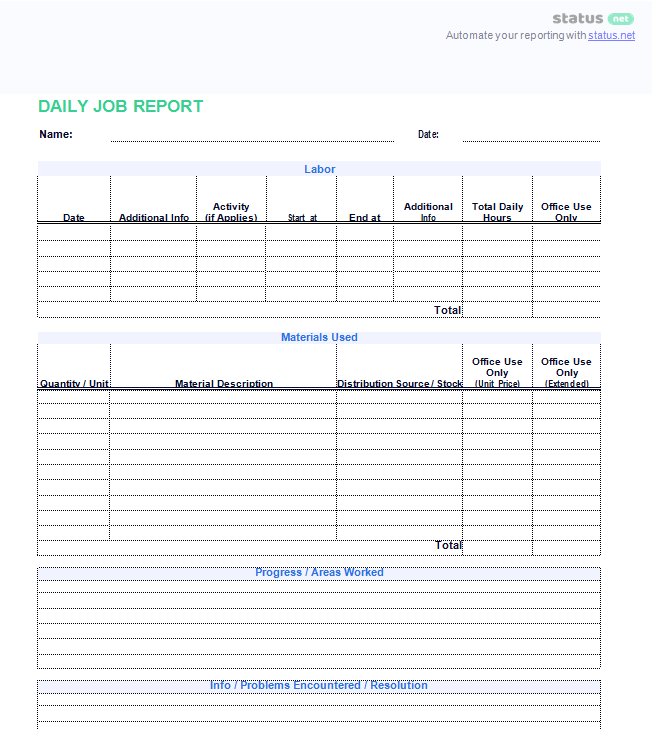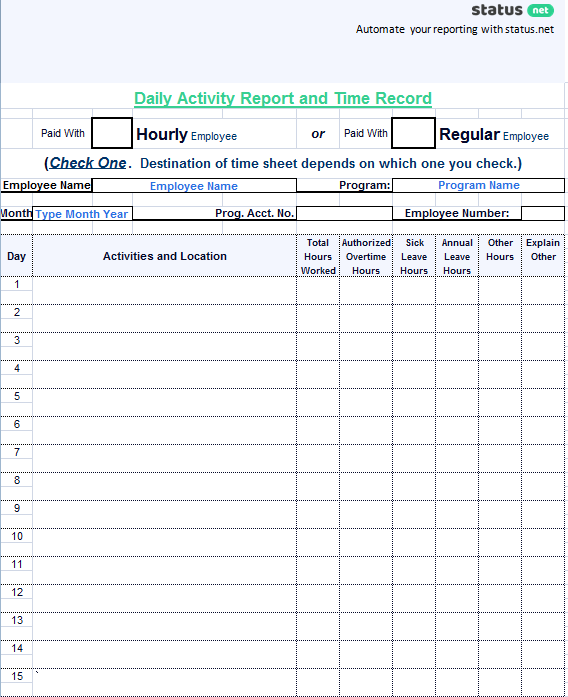 daily activity report template" width="250" height="280" />
daily activity report template" width="250" height="280" />Accounting for all progress of a project or a task, or for all activities accomplished and done within the day, a daily report is prepared by employees for submission to their supervisors. Usually daily report template contains space for details on how they spent their work day including their achievements and the challenges they encountered. Sometimes it also outlines the plans they have for the following day.
Daily report enables the team manager to have an overview how the team’s project is progressing in terms of each team member’s individual tasks without having to talk to each one on a daily basis. Daily reports are much more cost-efficient than to have a daily conversation which may not be consistent.
Daily status reports look into the day-to-day development of a project and to monitor whether is it complete according to plan or there is a delay for some reason. It is a useful tool to monitor if something implements smoothly or if there are certain factors which might affect performance.
Lastly, daily reports may also serve as a basis for the employee’s performance evaluation at the end of each term. Using these reports, managers may be able to see how the employee manages his tasks and his time, his decision-making skills, and his leadership abilities. Aside from that, it may also serve as a reference for the employee’s training and development interventions.
The content of the report needs to be structured, readable, and precise so it can be easily interpreted by all readers. Daily status report can be written in a formal or informal manner, depending on the company’s culture. It should contain the following information:
– A list of milestones that have been achieved;
– Any delays, issues, risks, uncertainties, and their current status;
– Plans for the following day;
– Any other information you feel is necessary for stakeholders to know about your progress.
Usually daily report focuses on three main points:
It might also be helpful to include what the employee learned during the day. It could be a practical learning—an easier way to do something, a new process that could speed up things, or any innovation to help improve the team or the organization. The learning could also be a conceptual one—a realization, an attitude change, or even a shift in the mindset.
The benefits of writing a good report are plentiful. It will help you maintain organized records of your company’s activities. It also helps you improve your work habits, because you can analyze your performance to see where improvements are needed. It’s also important for team collaboration and gives managers the opportunity to review their team’s progress. It helps employees become aware of their learnings as they work on the project and be able to share it with other team members.
Check this in-depth Guide to Daily and Weekly Reports to learn best practices how successful teams implement these reports to increase employee satisfaction, productivity, and transparency.
 daily activity report template" width="250" height="280" />
daily activity report template" width="250" height="280" />
 daily activity report template 2" width="250" height="278" />
daily activity report template 2" width="250" height="278" />
 daily activity report template 3" width="250" height="307" />
daily activity report template 3" width="250" height="307" />
The term “daily report” is often used interchangeably with “status report” or “progress report“. However, a status report typically only contains a person’s progress and may not detail what they learned during the day. A progress report is also different because it focuses more on the process of completing tasks.